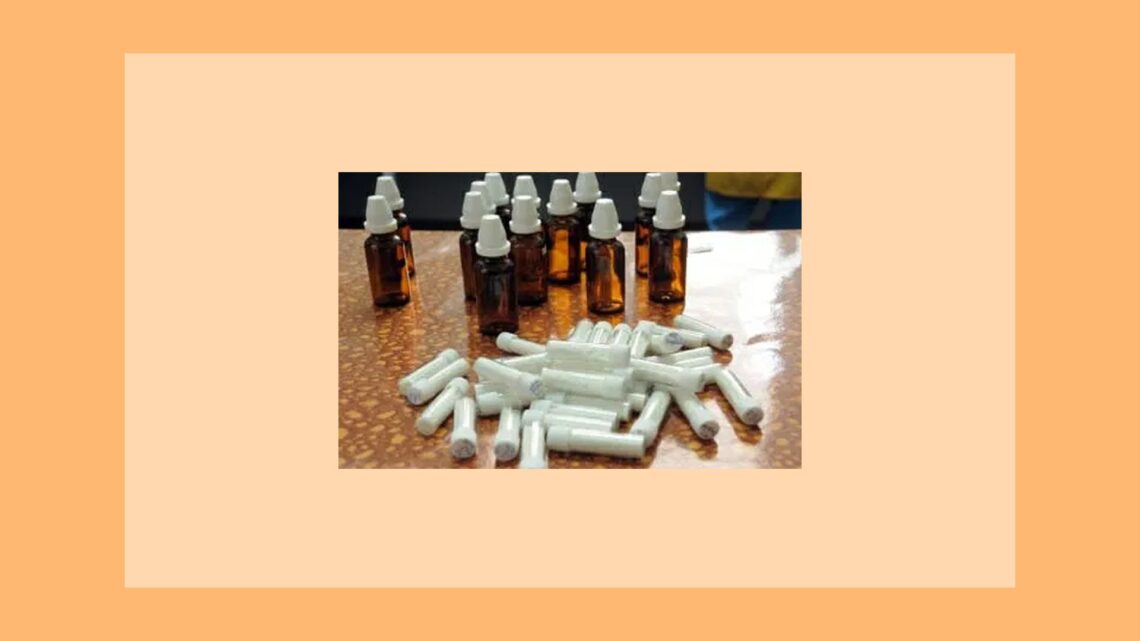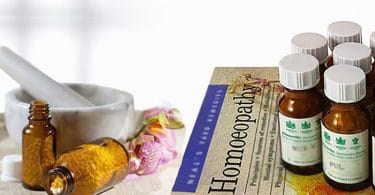Samuel Hahnemann introduced the (Lm-or) Q-Potency scale in his sixth and last edition of the Organon. It differs completely from the C-potency scale in preparation and application. Experiments, which he carried out from 1839 onwards, were only shared with close friends such as Clemens von Boenninghausen, G.H.G Jahr, Dr. Crosserio and his wife Melanie. Melanie Hahnemann continued using Q-potencies for a number of years after Samuel Hahnemann’s death.
First indications were given in the second edition of the Chronic Diseases, when he already advises to give remedies in watery solution, rather than single doses dry on the tongue. The sixth and last edition of the Organon was not published till 1921.
Even then, these breath-taking innovations nearly passed unnoticed as the homoeopathic community was deeply divided between high potency and low potency prescribing and was used to useing C-potencies. For the next 20 years little was published on Q-potencies in the Homoeopathic journals.
In 1956 Pierre Schmidt, a famous French homoeopath, was showing promising results with Q-potencies. The eighties and nineties saw their slow introduction into the day-to-day clinic in continental Europe. To date very little is published.
Organon
The manufacturing process of Q-potencies is accurately described in Organon 6th, ed. paragraphs: 269-271 of the Organon, 6th Ed. (Hint: Q- potencies are not made from 3c-potencies arrived by dilution and succuession. Instead, the Q-1 stage is always done by triturating. Check with your pharmacy.)
Other paragraphs relating to LM’ are: 161, 238, 246, 247, 248, 270, 271, 272, and 280, 281, 282.
Hahnemann claims that through this latest innovation he has solved the problem of aggravation hampering the use of C-potencies and also paved the way to a quicker and even more gentle way of treatment.
For C-potencies see Organon fifth edition (1835).
My practical application of Q-potencies:
In the following paragraphs, I will present my way of using the Q’s, which follows closely Hahnemann’s instructions taken from the Organon (sixth edition).
— LM’s (Q,) are stored in granular form.
— One (or a few) granules are dissolved in a 150ml glass bottle (Stock bottle), which is filled ¾ with water.
— The water should be clean and without any added chemicals.
— A small amount of high % alcohol is added next. (In my experience, this is only necessary if the medicine is not used up within 4 weeks)
— A scale, dividing the liquid into 7 parts is stuck to the side of the bottle. (Mark a dash every centimetre.)
— The bottle is shaken 10 times against something hard before every use. The patient does this preparation.
The remedy is applied in the following way:
Basic method:
1) one portion of the stock (1/7) is given into a 250ml glass and half filled up with water and stirred around.
2) Of that mixture 2 to 5 teaspoons are taken orally, the rest of the glass goes down the sink. (Alternatively the solution can be rubbed into the skin — (effective in infants), or inhaled)
In a normal case the remedy is repeated every 1 or 2 days. A bottle then lasts 7 to 14 days.
I usually leave 5 to10 days without remedy after finishing the bottle, to see what symptoms are expressed. This break enables the life force to freely express itself in symptoms, often indicating the next remedy through a change in the symptom- picture.
However, the remedy does not stop acting immediately, when the patient stops taking it. Deep and long acting remedies can act beneficially for months.
I instruct my patients to discontinue taking the remedy if following the first dose a striking improvement is noticed and to get in contact with me. This is often a sign that one dose is all it needs — every further repetition would spoil the case. I tell my patients to discontinue taking the remedy should there be any adverse reaction to the remedy.
Modifications to the basic method:
This basic method can be modified in many ways to suit the individual situation.
Frequency of repetition:
The remedy can be given only once every 7 days, even once a month in nicely advancing more chronic cases. The remedy can be given a few times a day out of the same glass, stirred around before every application. I gave up to 4 times 2 teaspoons in quick succession in fast advancing disease, before taking out the next lot from the stock bottle.
Strength of the individual dose:
The strongest single dose is one tablespoon taken straight from the bottle. This has caused aggravations similar to C-potencies. A somewhat weaker dose is one teaspoon straight from the bottle; an application I use more frequently.
If the standard application from the first glass is still too strong the impact of the single dose can be further weakened: One teaspoon from the first glass is given into a second glass, — this half filled with water and then one – three teaspoons taken orally. The medicine can be weakened further by going up to the seventh glass.
Simultaneously or alternatively to the oral application, or the remedy can be applied by olfaction (smelling it) or cutaneous (rub it in the skin).
Reactions after taking the medicine:
Reactions straight after taking the medicine:
Aggravation of single symptoms felt shortly after taking the remedy is due to sensitivity towards that remedy. Before changing to another remedy, the strength of the next dose should be weakened. Likewise, a drop of energy straight after taking the remedy is a certain sign of an impact on the upper limit.
If I still get the same reaction with a significantly weaker dose, I stop this remedy and retake the case. In many cases a remedy related to the former worked well.
I find that robust persons with good nerves can usually tolerate a teaspoon straight from the bottle without feeling any aggravation. Tense, stressed-out individuals only tolerate the first glass or even the third glass. If the third glass is tolerated a few times, I usually go back to the second glass and eventually to the first.
Adverse reactions after a few days:
If there is aggravation after a few days of taking the remedy, I stop giving the remedy and reassess the case as soon as the symptoms have settled. If this happens, it happens after 5 to 7 days. A more suitable remedy, which at the same time brings the case forward towards cure automatically stops the former remedy from acting.
During my 30 years of Q-potency use, I did different experiments:
I gave 10,15 or 20 doses from one stock bottle, shaking it ten times every time before use. After about the tenth dose the results were getting poorer and after the eighteenth dose proving symptoms were showing up. Currently I use up to single 10 applications from one Q-potency, and if the medicine is still indicated then after move on to the next higher potency.
Single proving-symptoms also showed quickly in susceptible individuals if I shook it only once or twice. This occurrence stopped when I shook it more than 5 times. It seems to me that after about 100 succussions to the bottle the remedy does not increase in potency any further and rather sharpens its action.
I also found that this limit of 100 successions is much lower if a smaller size stock bottle is used (50 or 100 ml.). This shaper action is sometimes desirable in very acute situations, where I need clear indications within a short period of time.
I have no experience in the use of 10 ml dropper -bottles containing the remedy in a 30% alcoholic dilution. I also tried to use up the stock bottle in only 3 lots, giving it about 25 succussions every time before each repetition. It worked out okay in acute cases, but there was no advantage in chronic cases.
Changeover from one potency scale to another:
If I change from the C-scale to the LM-scale I do it in the following way: 200c to Q2 –Q4 and 30c to Q1 – Q2. In return, every C-potency above the 30C follows any Q’ well.
When I return to an original remedy after a long time (1/2 year+, during which I gave other remedies), I start off with Q2 again. Not so if only one or two inter-current remedies were given in single doses. This suits the situation where the action of a deep and long acting remedy was interrupted by inter-current remedies, tackling acute situations.
Application of C-potencies:
I stock C-potencies in granular form in the strengths: 30C, 200C, 1M, 10M CM. I dissolve 1-2 granules or 1 tablet in a half empty ½ pint glass of water and give after a good stir 1 to 4 teaspoons as a single dose. Before repeating from the same glass: stir around ten times. I would not repeat more than 3 times of the same glass. This kind of repetition works well in acute cases if the glass containing the remedy is used within two days.
For more repeats, one can prepare C-potencies in a stock bottle like Q-potencies and apply accordingly. I usually divide into 7 to 10 doses and shake more than 10 times before every application. This application works much better than the application of a single dose dry under the tongue. (see Hahnemann, Chronic diseases vol.6)
If the same medicine is still indicated after the first bottle is finished and some time has lapsed, a higher or lower c-potency may be applied in the same way. The exact same potency twice in succession did not work well for me.
Adverse reactions to C-potencies are dealt in the same way as with Q-potencies, using the above method.
Sources:
I use my own stocks of C’, Q’s and LM’s. I get them from Helios in 2gr-granual vials. Lately, I also use Remedia (Austria) remedies. Remedia differentiates between LM and Q- potencies.
C-potencies are easy to get worldwide. I use granular form. It is important to be sure of the producer’s credentials. I am inclined to trust producers which document their source and production of their remedies.
Sending remedies:
I usually send out 2 or 3 granules of the same potency packed airtight in a sachet approximately the size of 3cm by 3cm. I send out more than one granule because they are very small and easily lost when the sachet is opened. I make and seal the sachets with a small machine otherwise used for sealing freezer bags. Normally I send them out by post attached to an information leaflet. This gives instructions on how to make up the stock-bottle and how to take the remedy. In cases that are more urgent, I use courier services here in Ireland.
Philosophical thoughts:
Administering a C- potency in a single dose is like giving the car a push and then leaving it roll on, till it eventually comes to a halt. With Q’s you drive the car through the gears until you reach the maximal comfortable speed and then keep it at the right speed. Your dosage follows the signals of the life-force. With Q’s you are in the driver’s seat all the time.
You can create a much more dynamic artificial disease with Q-potencies, which is similar to chronic diseases. Hahnemann reported, that through the use of LM’s the recovery time in chronic cases was more than halved, which is documented in his Paris journals.
From the live force’s point of view, an acute disease is a rather static disturbance like a thorn and therefore perfectly matched by a single dose of a remedy in C-potency or Q-potency.
Chronic diseases, especially Psora with its kaleidoscopic nature, have dynamism in themselves. The behaviour of this class of chronic diseases is far better matched by the nature of the Q’s.
Acceptance of Q-potencies by the patients:
Some C-potency using practitioners were concerned about the acceptance of Q-potencies by the patients, as the use of Q-potencies requires more involvement of the patient. It is my personal experience that using the Q-potencies had the opposite effect.
My patients feel safer, and more involved in their own recovery process. To be able to take medicine not only once off is more what my patients were accustomed to when taking allopathic medication. There is another advantage of the Q-potencies: The remedy’s action is very hard to disturb from the outside, as every successive dose puts the patient back on track.
Conclusion:
The use of Q-potencies reduces the recovery times significantly compared to C-potencies. In this fast moving world, the Q-potency is the answer to fast acting allopathic medications. A well-chosen fully potent remedy applied in Q-potency in the most suitable way has affected positive results quicker and with less side-effect’s than standardised allopathic medication.
I hope, that this concise article encourages other homeopaths to use Q-potencies in the best interest of their patient’s health and wellbeing.
©Hans Weitbrecht 2014 / 2021






Good article
Sirs, Interested to learn homeopathy. The background is BSc. medical laboratory sciences 1983, PGD. nutrition and food sciences 1988, the experience of 30 yrs in the laboratory, mainly microbiology. Kindly request advice.
Helios publicly concede:-
“We have a large range of LM potencies which have been prepared according to the Organon 6th edition (except that our vegetable remedies have been started using the 3c prepared by succussion in liquid dilution rather than trituration in lactose).” Does this concern you about your vegetable remedies?
Hi Hans, Hahnemann named his development of the “médicaments au globule” while living in France, using this French language term, which we now understand as the 50 Millesimal scale of potencies, and used the notation of 0/1, 0/2 etc. Hahnemann did not use the Q or LM abbreviations. The use of the abbreviation of Q is to stand for Quinquaginta milia, or fifty thousand in Latin; while LM is the Roman number for 950 which does not reflect the 50 Millesimal scale. This development of the 50 Millesimal scale of potencies was arguably the most significant change, comparing the fifth edition with the sixth edition of the Organon. For Hahnemann to request his second wife Mélanie to delay the publication of the sixth edition until after his death suggests that there was something very significant about this final edition of the Organon. The difference with the new dilution and succussion ratio alone is interesting, though the Decimal scale is yet another variation, though what is overlooked is that now in the sixth edition, ALL medicines are to be triturated to 3C in lactose before 0/1 is then prepared. Helios Pharmacy do not do this for their vegetable remedies, which make up 65% of the homeopathic materia medica. This requirement to triturate to 3C before preparing 0/1 is the BIG issue. The marc is no longer thrown away in preparing vegetable remedies. The next big issue is that in the sixth edition of the Organon, aphorism 128, Hahnemann still recommended conducting provings of remedies with a 30C remedy, and not a 50 Millesimal scale potency. How can you prescribe a 50 Millesimal scale medicine if it has not first been proven in a 50 Millesimal potency?
Pierre Schmidt is a Swiss homeopath and je used much more often C potencies